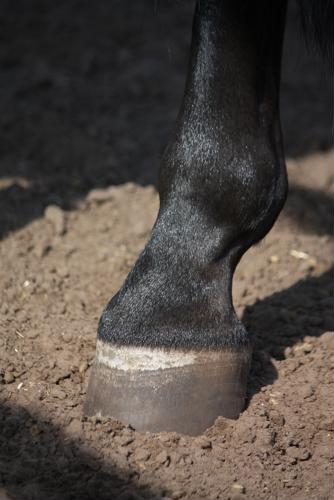When people think of the most vital part of a horse’s body – the one that contributes the most to their health – what typically comes to mind? Is it their muscle that allows them to move freely and work for hours on end? Do people consider it to be their mouths that allow them to nourish themselves? These are fundamentally important aspects of a horse’s physiology yet, but what about the horse’s hooves?
The hoof is the literal foundation that all horses stand on, and their roles in overall horse health cannot be overstated.
“The hooves absorb all of the concussive impact from the horse’s movement, so it is imperative the hoof is healthy to provide protection,” said Steve Blanchard, Finish Line Horse Products president. “Once the hoof is damaged, it increases the risk of other leg and body injuries. By taking care of the hoof, you are taking care of the horse in its entirety.”
A horse’s average weight is over 1,000 lbs. and all that weight must be supported by four hooves barely larger than a human hand. The old adage ‘no hoof, no horse’ has rung true for untold generations, because without the maintenance of the hooves, these animals known for their mobility would be virtually stationary.
Hoof basics
“A horse’s diet also plays a key role in their hoof health.”
Horses are known as ungulates, or animals that use the tips of their toes to support their weight when they move. According to Pet Assurance, the sole of the hoof is partially rubbery but hardens as it nears the outer walls. The hoof’s outermost layer is wrapped in a solid nail formation, and its tip has a hard, thick covering strengthened by keratin.
Hooves, like human fingernails, grow with time at a rate of about one-quarter inch per month. They need to be periodically trimmed so that they do not grow weak and cause cracks, chips and splays. These damages can lead to lameness, poor balance, discomfort, performance issues and eventually permanent damage to the hoof structure.
Ensuring hoof health
According to the Humane Society of Utah, when wild horses ran openly through their environments, their hooves adapted to the terrain and were naturally worn to safe levels through their explorations, without the need for human intervention. However, as the animals were domesticated and put into conditions unnatural to them, organic hoof upkeep ceased and humans have since assumed that responsibility.
Horse hoof health is determined by a number of factors including their genetics, their individual environments, nutrition and activity levels. Some of these factors can be controlled while others can’t. In any case, proper and timely care coupled with efficient feeding can ensure the health of any horse’s hooves.
Cleaning
Pet Assure stated a horse’s hooves should be cleaned on a daily basis and especially before and after riding sessions. Even horses that get ridden often should have their hooves cleaned to prevent thrush.
A hoof pick is the ideal tool for this task as it allows owners to efficiently clean debris like manure and soil from the underside of each hoof. Doing this is also a great time to assess the hoof’s overall health and check for cracks, punctures, abscesses, foreign objects and diseases.
Shoeing and trimming
If a horse is being ridden or worked, it’s suggested they receive shoes to protect their hooves from damage. Owners should find a quality farrier that can trim hoof growth and fit shoes to the equine. Professionals adept in the practice of trimming and shoeing can clip and angle the hoof and apply a shoe specific to a horse’s daily work requirements or the type of environment it lives in.
The University of Minnesota Extension recommends that during the summer, hooves be trimmed every six to eight weeks, and performance horses be trimmed even more frequently. During the winter hooves grow slower, so trimming is only necessary every six to 12 weeks, depending on the horse.
Nutrition
A horse’s diet also plays a key role in their hoof health. Hooves are comprised of dermal tissue like skin and hair, and require nutrients to maintain their strength and healthy growth and repair patterns.
A diet of quality hay, access to clean and fresh water and adequate supplementation of trace minerals are all necessary for proper nourishment. Nutrients such as biotin, niacin, calcium, methionine and zinc have all been proven to promote hoof health, and Finish Line’s Feet First, Coat Second contains many of these nutrients to meet a horse’s needs.








